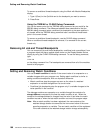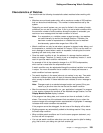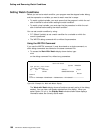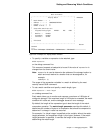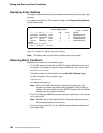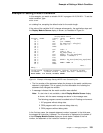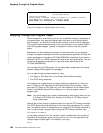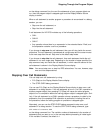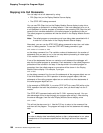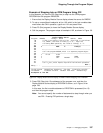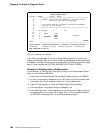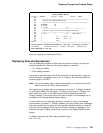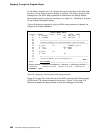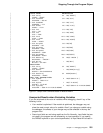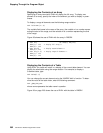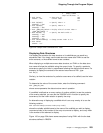
Stepping Through the Program Object
Stepping Into Call Statements
You can step into a call statement by using:
F22 (Step into) on the Display Module Source display
The STEP INTO debug command
You can use F22 (Step into) on the Display Module Source display to step into a
called program or procedure in a debug session. If the next statement to be run is
a call statement to another program or procedure, then pressing F22 (Step into) will
cause the first runnable statement in the called program or procedure to be run.
The called program or procedure will then be shown in the Display Module Source
display.
Note: The called program or procedure must have debug data associated with it
in order for it to be shown in the Display Module Source display.
Alternately, you can use the STEP INTO debug command to step into a call state-
ment in a debug session. To use the STEP INTO debug command, type:
STEP number-of-statements INTO
on the debug command line. The variable
number-of-statements
is the number of
statements that you want to run in the next step before processing is halted again.
If this variable is omitted, the default is 1.
If one of the statements that are run contains a call statement the debugger will
step into the called program or procedure. Each statement in the called program or
procedure will be counted in the step. If the step ends in the called program or
procedure, then the called program or procedure will be shown in the Display
Module Source display. For example, if you type
STEP 5 INTO
on the debug command line, the next five statements of the program object are run.
If the third statement is a CALL operation to another program object, then two
statements of the calling program object are run and the first three statements of
the called program object are run.
In the example of DEBUGEX, if you enter STEP INTO (or press F22) while on the
EVAL operation that calls the procedure c_proc, then you would step into the C
module.
The STEP INTO command works with the CL CALL command as well. You can
take advantage of this to step through your program after calling it. After starting
the source debugger, from the initial Display Module Source display, enter
STEP 1 INTO
This will set the step count to 1. Use the F12 key to return to the command line
and then call the program. The program will stop at the first statement with debug
data.
TIP
In order to display data immediately before or after a subprocedure is run, place
breakpoints on the procedure specifications that begin and end the subproce-
dure.
196 ILE RPG for AS/400 Programmer's Guide



